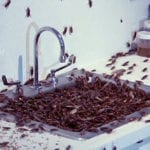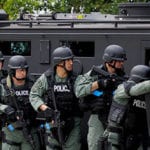 Technology
Technology  Technology
Technology  Religion
Religion 10 Catholic Histories That Reveal Acceptance of Abortion and Contraception
 Politics
Politics 10 Lesser-Known “First and Only” Facts about U.S. Presidents
 Miscellaneous
Miscellaneous 10 Things You May Not Know about the Fourth of July
 History
History 10 Shocking and Gruesome Founding Father Facts They Don’t Teach in School
 Crime
Crime The Ten Most Vicious Los Angeles Killers
 Miscellaneous
Miscellaneous 10 Indispensable Corporations the World Cannot Afford to Lose
 Animals
Animals 10 Unusual Wolves That Made The News
 Mysteries
Mysteries 10 Bizarre, Little-Known Phenomena
 Music
Music 10 Musicians Who Changed How Everyone Plays Their Instruments
 Technology
Technology 10 Little-Known Shifts in Computer Science
 Religion
Religion 10 Catholic Histories That Reveal Acceptance of Abortion and Contraception
 Politics
Politics 10 Lesser-Known “First and Only” Facts about U.S. Presidents
Who's Behind Listverse?

Jamie Frater
Head Editor
Jamie founded Listverse due to an insatiable desire to share fascinating, obscure, and bizarre facts. He has been a guest speaker on numerous national radio and television stations and is a five time published author.
More About Us Miscellaneous
Miscellaneous 10 Things You May Not Know about the Fourth of July
 History
History 10 Shocking and Gruesome Founding Father Facts They Don’t Teach in School
 Crime
Crime The Ten Most Vicious Los Angeles Killers
 Miscellaneous
Miscellaneous 10 Indispensable Corporations the World Cannot Afford to Lose
 Animals
Animals 10 Unusual Wolves That Made The News
 Mysteries
Mysteries 10 Bizarre, Little-Known Phenomena
 Music
Music 10 Musicians Who Changed How Everyone Plays Their Instruments
10 Ways WWII Changed the Allied Home Front
Aerial bombardments; labor shortages; and insufficient food, materials, and natural resources were only some of the hardships that men, women, and children faced on the home front during World War II. The devastation of The Great War meant that everyone must do their part, regardless of sex, age, or location.
Back home, ordinary citizens rose to the occasion, their heroic sacrifices and labor on behalf of the Allied nations’ fighters helping their military men and women win the long, hard-fought war against the Axis powers. Without a doubt, the valiant, patriotic contributions of such workers as Land Girls, Lumber Jills, and Factory Girls helped the Allies to win the war.
Unfortunately, there were also undesirable changes on—and to—the home front. Without a doubt, World War II changed the home front, sometimes temporarily, other times permanently, for both good and ill.
While it would take a library to fully document all these changes in detail, this list of ten ways WWII changed the home front provides a glimpse into some of the major transformations that resulted from this devastating global conflict.
Related: Top 10 Crazy World War II Food Substitutes
10 Aerial Bombardment
The aerial bombardment campaign that the German air force, or Luftwaffe, conducted against the United Kingdom and other countries began at the outset of World War II in 1939 and continued until the end of the global conflict in 1945. For these six years, the Luftwaffe more or less continuously bombed London, dropping both heavy explosives and incendiary devices night after night.
The seemingly endless onslaught was directed at many other British towns as well, including some of the most beautiful cities in England, the Luftwaffe adding rocket attacks to their arsenal during the last two years of the war. The potential number of victims was massive. London itself was home to eight million, but this number swelled to ten million when the population was counted as including the city’s greater metropolitan area.
An observer described the sight of “hundreds of” incoming Luftwaffe bombers as a swarm that was “amazing, impressive, [and] riveting,” filling the sky above and resembling “bees around their queen.”
The city’s East End docks and Central, West, and South London came under successive bombardments, followed by aerial assaults on the suburbs. Neither people, their homes, nor the city’s most beloved architectural masterpieces were spared, including Buckingham Palace, which was struck sixteen times, and the Palace of Westminster, which endured fourteen such attacks during the Blitz of 1940-1941. London’s historic churches and cathedrals were bombed, too, sustaining serious damages. The Luftwaffe also carried out extensive air attacks on rural targets.[1]
9 All-American Girls Professional Baseball League Players Association
Although President Franklin D. Roosevelt supported the continuation of Major League Baseball after the United States entered World War II in 1941, there was a problem. The players were trading their baseball uniforms for those of their country’s fighting forces. In 1943, chewing gum magnate Philip K. Wrigley, who owned the Chicago Cubs, came to the rescue, founding the All-American Girls Professional Baseball League Players Association.
Wrigley considered the all-women’s league a temporary wartime measure, certain that it would disband when the conflict ended. Instead, the all-women’s league continued drawing crowds, with more than 900,000 fans attending the 1948 season. The league didn’t disband until 1954, ending a twelve-year run that featured over 500 players and later inspired the 1992 all-star movie A League of Their Own, starring Tom Hanks, Geena Davis, and Madonna, among others.[2]
8 Blackouts
Blackouts were simple but effective defenses against aerial bombardment, preventing the pilots of enemy aircraft from discerning targets due to seeing vehicles’ headlights, streetlights, residential lighting, or, as an archived website’s article adds, even “the red glow of a cigarette.”
In England, lights were banned—period. This resulted in an entire city or coastline being plunged into darkness. Prior to the war, Britain’s Air Ministry had predicted that the UK would be subjected to “sudden air attacks,” resulting in many casualties and massive “destruction from enemy night bombers.” Without ground lights, however, the pilots of such aircraft would find both navigation and target acquisition difficult. And the nation’s Air Raid Patrol called on every citizen to help ensure blackout regulations were properly enforced.
Driving at night without the benefit of headlights proved “confusing, frightening, and dangerous.” Accidents increased, as did drownings when drivers drove off bridges. In one case, after a passenger, mistaking an unscheduled stop for his arrival at a station, stepped off a train, he fell eighty feet into a viaduct, ending up in the hospital.
Another downside to blackouts was an increase in crime as pickpockets and thieves took advantage of the darkness, although the increase was not as drastic as some believed, since criminals feared that, should they break into a house, they might come face to face with the resident.
In the United States and other countries, similar blackout restrictions were enforced until, in April 1945, these measures were finally rescinded for good.[3]
7 Bomb Shelters
In Britain, underground bomb shelters offered protection against aerial bombardment. For example, an Anderson shelter (named in honor of Home Secretary Sir John Anderson) was essentially a corrugated iron shed, measuring 6ft 6in x 4ft 6in (2m x 1.4m). The government ordered a total of 2,500,000 of them. Although only 100,000 were sold, each of them was effective in protecting up to as many as six adults, and many families survived in their Anderson shelters while their homes were flattened.
Although they protected the people inside, these shelters weren’t comfortable—or comforting, for that matter. Cramped underground spaces, they were not soundproof, a fact that tended to amplify the terrible din of an air raid: the “whistle of falling bombs, the canon fire of RAF fighters, and the thunderous booming of British guns.” In addition, public shelters, some constructed in parks, were made available.
Larger public shelters could pose dangers to those who sought refuge in them. During a mass exodus from the streets into an Underground station shelter, when a woman tripped on the stairs, 173 people were killed, and more than 60 were injured in the crush that followed.[4]
6 Censorship
On December 7, 1941, the Imperial Japanese Navy Air Service attacked Pearl Harbor. Twelve days later, President Roosevelt created the Office of Censorship, authorizing the editing or suppression of “any message entering or leaving the United States by mail, cable, or radio.” The government’s domestic censorship policy remained in effect until the Japanese surrendered on August 15, 1945. Government censorship also occurred in other countries, including Canada, under its War Information Board directives and guidance.
Although some censorship appears to have been petty and arbitrary, other censored material was significant, such as news concerning the development of the atomic bomb. According to the Office of Censorship’s director, Byron Price, the news media voluntarily agreed to stifle themselves for the good of the country. However, in the words of the Lawrence, Kansas, Daily Journal-World, Price admitted that “there were some [minor] leaks,” the director believing that they were probably “not deliberate.” In all, Price was satisfied that “the long work on the atomic bomb was the best-kept single secret of the war.”[5]
5 Propaganda
During World War II, propaganda took many forms, including those in films, on posters, and even, oddly enough, in comic books. As Paul S. Hirsh points out in Pulp Fiction: The Secret History of Comic Book Imperialism, comic books, which are visually oriented, easy to read, and exciting, if unsophisticated, were widely read among both soldiers and civilians.
For this reason, among others, such publications attracted the attention of the Writers War Board as a potent means of delivering propaganda. Providing propaganda favorable to the war effort was regarded as a win-win situation by comic book companies, too, whose executives could demonstrate their patriotic credentials while gaining millions of new readers.
One such heroic soldier was DC Comics’ Sgt. Rock, who was described as carrying on the tradition of serving his country by enlisting at the rank of private in the early days of World War II. He then occupied the “same mythical space for enlisted men” as that of Marvel Comics’ Captain America, who epitomized the “officer who could protect you during the war.”
Indeed, on the March 1941 cover of Captain America Comics, the hero in the red-white-and-blue costume is shown punching Adolf Hitler. As Marvel’s editor Stan Lee himself pointed out, just before World War II began, “many of our super heroes, especially Captain America, the Human Torch, and the Sub-Mariner, were already fighting Hitler and the Nazis.”[6]
4 Factory Girls and Military Auxiliaries and Reservists
In addition to his being a misanthropic madman, Hitler was also quite sexist. As the National World War II Museum website points out, the Führer believed that women’s proper places were the home and the maternity ward: “The role of German women,” he said, “was to be good wives and mothers and to have more babies for the Third Reich.”
On the home front, American women took over the factory jobs that the nation’s men had done prior to joining the military. Not only did women continue to maintain their homes and rear their children, but they also took on jobs in defense plants and volunteered for war-related organizations. Some of them even served aboard trolleys as “conducterettes.”
Nor did these roles define the limits of women’s capabilities. According to Stephen Ambrose, author of D Day, they also “managed the finances and learned to fix the car.” In addition, they served in the auxiliaries or reserves of the U.S. Army, Navy, Marine Corps, and Coast Guard, performing the jobs of clerks, truck drivers, aircraft mechanics, lab technicians, parachute riggers, radio operators, photography analysts, military pilots, test pilots, and training assistants.
Although they did not perform combat roles, they did serve as nurses near the front lines, and 16 were killed by direct enemy fire, while 68 were captured as POWs in the Philippines. General Dwight D. Eisenhower attributed the Allies’ success against the Axis powers in part to the valiant efforts of American women, without whose assistance, he suggested, the war might well have had a different outcome.[7]
7 Land Girls
As John Christopher and Campbell McCutcheon point out in The Second World War in Photographs 1939, with so many men gone to war, the UK was short on farm labor. A call for volunteers, whose numbers would later be bolstered by “conscripts,” resulted in a corps of 80,000 “Land Girls,” as the substitute workers were popularly known.
Although initially, they were not universally appreciated, their hard work won over their detractors. The women proved themselves adept at driving tractors, thatching, sharpening “wooden stakes for fencing, and packing sugar beet into a silo.”[8]
2 Lumber Jills
One of the ways in which women in the UK aided the war effort was to serve as substitutes for lumberjacks who’d enlisted in the military. Known informally as “Lumber Jills,” these members of the Women’s Timber Corps, established in 1942 as a branch of the Land Army, felled and measured trees, loaded lumber aboard trucks, and drove vehicles. Their effort was crucial in helping to supply timber to wartime industries.
Although their hours were a bit shorter than those of the Land Girls, the workdays were plenty long enough, lasting from 7:00 am to 4:30 pm. Their shorter hours, as compared to those of Land Girls, made some think Lumber Jills had it easier than Land Girls. Still, the fact that Lumber Jills had to pass a stricter medical examination than Land Girls did suggests otherwise, as does an interview with Lumber Jill Joy Smith.
In February 1943, Smith entered the Women’s Timber Corps at age eighteen. During her training at Culford Camp, she lived in a Litton hut and learned to “wield an ax” and a crosscut saw, to operate a buzz saw, to fell trees and cut them into four-foot lengths, and to load the cut section onto “lorries.” After training, she and the other Lumber Jills were deployed to various parts of the UK—where they were housed with local families—to perform logging operations.[9]
1 Japanese Internment Camps
Probably the most horrendous change that occurred to the home front as a result of World War II was the establishment of Japanese internment camps in the United States, Canada, and Australia. President Roosevelt’s Executive Order 9066, signed in February 1942, authorized the removal of individuals from military areas “as deemed necessary or desirable,” notes Rachel A. Bailey, author of The Japanese Internment Camps. The meaning of military areas was vague, which might have helped the entire West Coast to be defined as one.
Bailey gives a harrowing, first-person account of how her own family was forced to vacate their residence. Her mother had expected such an occasion to occur, Bailey writes, and had sold the family’s belongings, including books, toys, linens, and even their “dog, for next to nothing.”
When the notice to vacate arrived, the family was put on a bus and taken to the Owens Valley Reception Station (later Manzanar) and permitted to bring with them only that which they could carry, usually only duffel bags stuffed with their belongings. The family was identified by the number attached to their bags. The center at which they would be held consisted of 36 blocks, each containing 14 barracks, surrounded by desolate desert.
Their cramped apartment was equipped with “a lone light bulb” hanging from the ceiling and “eight army cots with mattresses stuffed with straw and blankets.” There was no private bathroom, only communal toilets in a separate barracks. The families took their meals in the camp’s mess hall.
A map depicting the layout of the camp to which Bailey and her family were sent shows a hospital, an orphanage, a department store, a Catholic church, a music hall, a Buddhist church, an outdoor theater, a fire station, a judo dojo, a Protestant church, an auditorium, a police station, a sentry house, a town hall, a post office, staff housing, camp facility buildings, garages, picnic grounds and, at intervals along all four walls enclosing the camp, guard towers, all compacted into an area about a mile wide by a mile-and-a-half long (1.6 kilometers by 2.4 kilometers).
Besides California’s Owens Valley, or Manzanar, and Tule Lake, there were nine other camps scattered over various other states.
Under the authority of the War Measures Act, the Canadian government, beginning in 1942, “detained and dispossessed more than 90 percent of Japanese Canadians” for the duration of World War II, seizing and selling the detainees’ homes and businesses to pay for their detention. Detainees were allowed only the belongings they could carry and were detained in camps in various locations across the country or, in some cases, allowed to work on sugar beet farms, where they would be able to “keep their families intact.” Conditions were grim, characterized by overcrowding, a lack of electricity, and running water.
On May 9, 1941, the Australian War Cabinet decreed that, should the country be drawn into the war, “all Japanese males over 16” who lived in Australia or Australian territories “would be interned.” And when hostilities occurred in December, very few first- or second-generation Japanese escaped internment in Australia’s Wartime Internment Camps, including “even elderly people in nursing homes.”[10]








